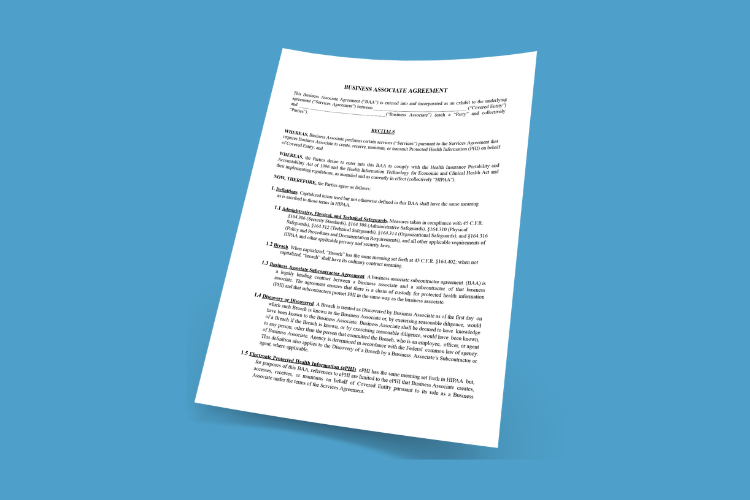Adhering to the Health Insurance Portability and Accountability Act (HIPAA) standards is crucial to uphold compliance and regulatory requirements for any health organization. This act safeguards patients’ protected health information (PHI) and health plans and defines security and privacy regulations regarding patient data.
Because enterprise healthcare organizations may employ hundreds or thousands of people, having a HIPAA compliance checklist helps to effectively manage the complexities of protecting patient information, reducing the risk of violations, and maintaining a culture of compliance throughout the organization.
What Is HIPAA?
HIPAA, enacted in 1996, originally aimed to improve health insurance portability and reduce healthcare fraud. It evolved to include crucial privacy and security protections for patients’ health information. The law established national standards for protecting medical records and personal health data, applying to healthcare providers (e.g., physicians, clinics, hospitals), health plans (e.g., insurance companies, HMOs), healthcare clearinghouses, and business associates of covered entities.
The U.S. Department of Health and Human Services (HHS) Office for Civil Rights (OCR) enforces HIPAA rules. Violations can result in civil monetary penalties and, in some cases, criminal penalties.
HIPAA’s purpose and scope are to:
- Improve the portability and continuity of health insurance coverage
- Combat waste, fraud, and abuse in health insurance and healthcare delivery
- Promote the use of medical savings accounts
- Simplify the administration of health insurance
- Ensure the privacy and security of health information
The Act is comprised of three components:
- Privacy Rule: Establishes national standards for protecting individuals’ medical records and other personal health information. It requires appropriate safeguards to protect the privacy of personal health information and sets limits and conditions on the uses and disclosures of such information without patient authorization.
- Security Rule: This rule creates national standards to protect electronic personal health information created, received, used, or maintained by covered entities. It requires appropriate administrative, physical, and technical safeguards to ensure the confidentiality, integrity, and security of electronic protected health information (ePHI).
- Enforcement Rule: Contains provisions relating to compliance and investigations and the imposition of penalties for violations of the HIPAA rules.
HIPAA’s Influence on Healthcare Operations
HIPAA is the regulatory framework with the most profound impact on a healthcare organization’s day-to-day operations. The legislation goes beyond merely safeguarding patient information; it fundamentally reshapes how healthcare organizations function across multiple domains.
Workforce-Wide Implications
One of HIPAA’s most far-reaching effects is its influence on every healthcare organization’s staff member. From front-desk receptionists to top-level executives, all personnel must undergo HIPAA training and adhere to its guidelines. This universal requirement significantly alters workplace protocols and decision-making processes at all levels.
Technological Considerations
The HIPAA Security Rule has a transformative effect on the technological landscape of healthcare organizations. It mandates specific security measures for ePHI, including:
- Robust encryption protocols
- Stringent access control systems
- Regular security audits and healthcare security risk assessment
These requirements often necessitate substantial investments in IT infrastructure and cybersecurity measures, directly impacting an organization’s technological strategy and budget allocation.
Vendor Relationships and Third-Party Interactions
HIPAA’s reach extends beyond the healthcare provider’s immediate operations to encompass their business associates and vendor network. The regulation stipulates that any entity with access to PHI must comply with HIPAA standards. This requirement fundamentally alters how healthcare organizations select, contract with, and manage their external partnerships.

Download this BAA - already updated with 2024 HIPAA Final Rule changes.
Operational Consequences of Non-Compliance
The potential repercussions of HIPAA violations are severe, including hefty fines, legal action, and reputational damage. This reality compels healthcare providers to prioritize HIPAA compliance in their risk management strategies and operational planning, further underscoring the regulation’s pervasive impact on healthcare operations.
Your Comprehensive HIPAA Compliance Checklist
Your healthcare organization needs a HIPAA compliance checklist to manage patient data protection across a complex workforce effectively. The checklist helps standardize practices, reduce breach risks, ensure regulatory compliance, guide staff training, and prepare for audits.
This checklist is designed to help implement safeguards, conduct assessments, and maintain consistent HIPAA-compliant procedures. It ultimately protects the organization from penalties and preserves patient trust.
HIPAA Compliance Checklist
Appoint Responsible Personnel
- Designate a HIPAA Privacy Officer and Security Officer
- Develop written privacy and security policies
Ongoing Organizational Training
- Develop a comprehensive training program covering all HIPAA-related aspects relevant to your organization.
- Ensure all employees, including new hires, receive initial HIPAA training.
- Conduct regular refresher training sessions, typically annually or more frequently if needed.
- Document all training activities, including content, dates, and attendees.
- Use a healthcare learning management system (LMS) to deliver and track training efficiently.
- Include both general HIPAA principles and role-specific training tailored to different job functions.
- Evaluate the effectiveness of training through assessments or practical exercises.
Administrative Safeguards
- Conduct annual audits with healthcare risk management software
- Security Risk Assessment
- Privacy Standards Audit (Not required for BAs)
- HITECH Subtitle D Privacy Audit
- Security Standards Audit
- Asset And Device Audit
- Physical Site Audit
- Implement a security awareness training program for all staff
- Develop and maintain HIPAA-compliant policies and procedures
- Stay informed about HIPAA updates and incorporate changes into policies and procedures
Technical Safeguards
- Implement access controls and audit logs for electronic PHI (ePHI)
- Use encryption for data at rest and in transit
- Establish secure backup and disaster recovery procedures
Physical Safeguards
- Secure physical access to areas containing PHI
- Implement proper disposal procedures for PHI
Privacy Measures
- Develop and implement patient rights policies (e.g., right to access, amend, and receive an accounting of disclosures)
- Create and maintain HIPAA-compliant forms (e.g., Notice of Privacy Practices, authorization forms)
Breach Notification Procedures
- Establish a process for identifying and reporting breaches
- Develop a breach notification policy and response plan
Download a ready-to-use HIPAA Breach Notification Policy template.
Business Associate Management
- Identify all business associates
- Execute HIPAA-compliant Business Associate Agreements
Download a ready-to-use Business Associate Agreement.
Documentation and Record-Keeping
- Maintain thorough documentation of all HIPAA-related policies, procedures, and activities
- Establish a process for regular review and updates of HIPAA documentation
Manage HIPAA Compliance With MedTrainer
Healthcare organizations must recognize that HIPAA compliance involves more than using a checklist. All-in-one compliance software from MedTrainer provides your leaders with a comprehensive approach to educating employees on the core principles of HIPAA, especially concerning ePHI. MedTrainer’s robust learning management system (LMS) simplifies HIPAA initial and refresher training with available microlearning options.
MedTrainer supports HIPAA compliance efforts for healthcare facilities by enabling them to:
- Complete required HIPAA training in an online learning management system.
- Centralize and securely store policies and procedures related to HIPAA compliance.
- Streamline the process of policy creation, approval, and distribution.
- Provide version control and document history for audit purposes.
- Automate policy acknowledgments and employee training tracking.
- Customize reporting for audits and surveys by maintaining a comprehensive record of policy adherence and employee training.
Contact MedTrainer to learn how all-in-one compliance software can bolster your HIPAA adherence efforts.
